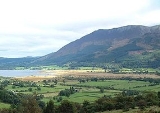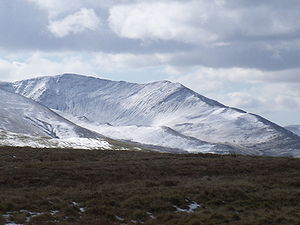
Ullock Pike
Encyclopedia
Ullock Pike is a fell
situated in northern part of the English Lake District
. It is located seven kilometres north west of Keswick
and achieves a height of 692 metres (2270 feet). The fell sits on Skiddaw
’s south western ridge along with two other fells (Long Side
and Carl Side
), this ridge is regarded as the finest way to ascend Skiddaw, with Alfred Wainwright
commenting:
“There is no doubt in my mind that by far the best approach to the top of Skiddaw is by way of its north-west ridge. This offers a fine expedition along a narrow crest in exciting surroundings and provides excellent views throughout … for the collector of summits here are three waiting to be picked off in addition to Skiddaw”.
language and translates as "The peak where the wolves play". With úlfr meaning wolf and leikr meaning play, there is records that the fell was called Ulvelaik in the 13th century.
. When viewed from the north Ullock Pike is observed as a slender peak which catches the eye but from other directions it is seen as just a bump at the end of Longside Edge. The fell of Long Side is just 600 metres away along the ridge to the south west and Ullock Pike has just 14 metres of Topographic prominence
from it and therefore fails to qualify as a Hewitt or a Nuttall and relies on Wainwright to give it the status of a separate fell, which he does mainly because of the quality of the view and the excellence of its form from the north.
There is a low lying outlying top to Ullock Pike, which stands 1.5 kilometres away along the northern ridge and has the unusual name of Watches, with a height of 333 metres it is a distinctive summit made more remarkable by an unusual rash of Igneous rock
s amongst the grass and local Skiddaw slate
which give the initial impression of being an ancient stone circle or even a small quarry but are apparently a natural rock formation.
the Kirk Stile Formation of the Skiddaw Group predominates. This is composed of laminated mudstone
and siltstone
with greywacke
sandstone and is of Ordovician
age. There are many small intrusions of lamprophyre
and diorite
.
which gives a fine all round view even though it is curtailed by the bulk of Skiddaw to the east.
Fell
“Fell” is a word used to refer to mountains, or certain types of mountainous landscape, in Scandinavia, the Isle of Man, and parts of northern England.- Etymology :...
situated in northern part of the English Lake District
Lake District
The Lake District, also commonly known as The Lakes or Lakeland, is a mountainous region in North West England. A popular holiday destination, it is famous not only for its lakes and its mountains but also for its associations with the early 19th century poetry and writings of William Wordsworth...
. It is located seven kilometres north west of Keswick
Keswick, Cumbria
Keswick is a market town and civil parish within the Borough of Allerdale in Cumbria, England. It had a population of 4,984, according to the 2001 census, and is situated just north of Derwent Water, and a short distance from Bassenthwaite Lake, both in the Lake District National Park...
and achieves a height of 692 metres (2270 feet). The fell sits on Skiddaw
Skiddaw
Skiddaw is a mountain in the Lake District National Park in England. With a summit at 931 m above sea level it is the fourth highest mountain in England. It lies just north of the town of Keswick, Cumbria, and dominates the skyline in this part of the northern lakes...
’s south western ridge along with two other fells (Long Side
Long Side
Long Side is a fell in the English Lake District, it is situated six kilometres north west of Keswick in the northern sector of the national park and is part of the Skiddaw group of fells. Long Side which reaches a height of 734 m is located on Skiddaw’s north western ridge, the middle...
and Carl Side
Carl Side
Carl Side is a fell in the English Lake District, forming a part of the Skiddaw "family" near the town of Keswick and prominently visible from its streets...
), this ridge is regarded as the finest way to ascend Skiddaw, with Alfred Wainwright
Alfred Wainwright
Alfred Wainwright MBE was a British fellwalker, guidebook author and illustrator. His seven-volume Pictorial Guide to the Lakeland Fells, published between 1955 and 1966 and consisting entirely of reproductions of his manuscript, has become the standard reference work to 214 of the fells of the...
commenting:
“There is no doubt in my mind that by far the best approach to the top of Skiddaw is by way of its north-west ridge. This offers a fine expedition along a narrow crest in exciting surroundings and provides excellent views throughout … for the collector of summits here are three waiting to be picked off in addition to Skiddaw”.
Name
The fell's name comes from the Old NorseOld Norse
Old Norse is a North Germanic language that was spoken by inhabitants of Scandinavia and inhabitants of their overseas settlements during the Viking Age, until about 1300....
language and translates as "The peak where the wolves play". With úlfr meaning wolf and leikr meaning play, there is records that the fell was called Ulvelaik in the 13th century.
Topography
Ullock Pike drops away steeply on its eastern side to the little known valley of Southerndale while its western slopes which are clothed in woodland lower down fall to Bassenthwaite LakeBassenthwaite Lake
Bassenthwaite Lake is one of the largest water bodies in the English Lake District. It is long and narrow, approximately long and wide, but is also extremely shallow, with a maximum depth of about ....
. When viewed from the north Ullock Pike is observed as a slender peak which catches the eye but from other directions it is seen as just a bump at the end of Longside Edge. The fell of Long Side is just 600 metres away along the ridge to the south west and Ullock Pike has just 14 metres of Topographic prominence
Topographic prominence
In topography, prominence, also known as autonomous height, relative height, shoulder drop , or prime factor , categorizes the height of the mountain's or hill's summit by the elevation between it and the lowest contour line encircling it and no higher summit...
from it and therefore fails to qualify as a Hewitt or a Nuttall and relies on Wainwright to give it the status of a separate fell, which he does mainly because of the quality of the view and the excellence of its form from the north.
There is a low lying outlying top to Ullock Pike, which stands 1.5 kilometres away along the northern ridge and has the unusual name of Watches, with a height of 333 metres it is a distinctive summit made more remarkable by an unusual rash of Igneous rock
Igneous rock
Igneous rock is one of the three main rock types, the others being sedimentary and metamorphic rock. Igneous rock is formed through the cooling and solidification of magma or lava...
s amongst the grass and local Skiddaw slate
Skiddaw Slate
Skiddaw slate is an early Ordovician metamorphosed sedimentary rock, as first identified on the slopes of Skiddaw in the English Lake District....
which give the initial impression of being an ancient stone circle or even a small quarry but are apparently a natural rock formation.

Geology
In common with much of the Northern FellsNorthern Fells
The Northern Fells are a group of hills in the English Lake District. Including Skiddaw, they occupy a wide area to the north of Keswick. Smooth sweeping slopes predominate with a minimum of tarns or crags...
the Kirk Stile Formation of the Skiddaw Group predominates. This is composed of laminated mudstone
Mudstone
Mudstone is a fine grained sedimentary rock whose original constituents were clays or muds. Grain size is up to 0.0625 mm with individual grains too small to be distinguished without a microscope. With increased pressure over time the platey clay minerals may become aligned, with the...
and siltstone
Siltstone
Siltstone is a sedimentary rock which has a grain size in the silt range, finer than sandstone and coarser than claystones.- Description :As its name implies, it is primarily composed of silt sized particles, defined as grains 1/16 - 1/256 mm or 4 to 8 on the Krumbein phi scale...
with greywacke
Greywacke
Greywacke or Graywacke is a variety of sandstone generally characterized by its hardness, dark color, and poorly sorted angular grains of quartz, feldspar, and small rock fragments or lithic fragments set in a compact, clay-fine matrix. It is a texturally immature sedimentary rock generally found...
sandstone and is of Ordovician
Ordovician
The Ordovician is a geologic period and system, the second of six of the Paleozoic Era, and covers the time between 488.3±1.7 to 443.7±1.5 million years ago . It follows the Cambrian Period and is followed by the Silurian Period...
age. There are many small intrusions of lamprophyre
Lamprophyre
Lamprophyres are uncommon, small volume ultrapotassic igneous rocks primarily occurring as dikes, lopoliths, laccoliths, stocks and small intrusions...
and diorite
Diorite
Diorite is a grey to dark grey intermediate intrusive igneous rock composed principally of plagioclase feldspar , biotite, hornblende, and/or pyroxene. It may contain small amounts of quartz, microcline and olivine. Zircon, apatite, sphene, magnetite, ilmenite and sulfides occur as accessory...
.
Ascents
There are two possible starting points for the ascent of Ullock Pike from the north, the one from the Ravenstone Hotel at grid reference is hampered by a lack of parking space but does have a bus stop (there is parking in Dodd Wood 1.5 km to the south). The other starting place is at on the minor road to Orthwaite, both routes utilise the northern ridge to climb the fell, there is a significant false top which is in view for a long time before the true summit is attained.Summit and View
The top of the fell is a small neat spot carpeted with heatherCalluna
Calluna vulgaris is the sole species in the genus Calluna in the family Ericaceae. It is a low-growing perennial shrub growing to tall, or rarely to and taller, and is found widely in Europe and Asia Minor on acidic soils in open sunny situations and in moderate shade...
which gives a fine all round view even though it is curtailed by the bulk of Skiddaw to the east.

